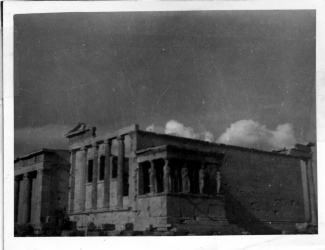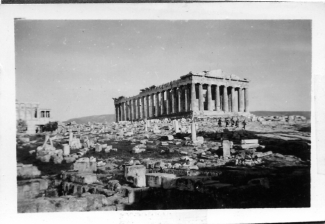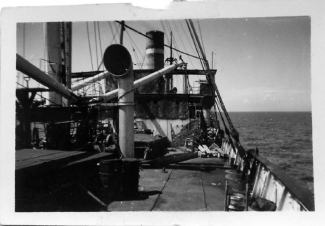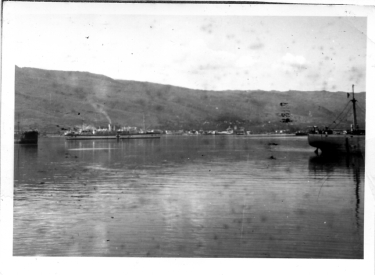

by Edward Anthony (Tony) Clarke, February 2007
The Greek campaign
began in 1940 when an Italian attempt to invade was held by the Greek forces
with small British assistance. The Greeks then forced the enemy back into Albania.
Churchill had promised to aid Greece in the event of need and, with the Germans
appearing on the northern border, to save the debacle General Wavell in Egypt
was ordered to send more than half his troops and equipment across the Med.
With the Italians in full retreat across north Africa the obvious need to drive
them back into Tripoli and clear them out completely was the Generals’
request but quashed by the politicians.
So some 58,000 Australian, New Zealand and English men were on their way with half of Tony’s unit, 2BPFC (Base Petrol Filling Company) amongst them, the other half being sent to Tobruk to be cut off there with the, to be, heroic 'Rats of Tobruk'. They were ordered, again by Churchill, "To Hold It" but that’s another story.
To begin with the Unit was Camped somewhere NE of Athens in the Greek countryside.
 |
 |
They had no equipment to aid the force except a Lewis Gun (modern in1914 but liable to jamb at the wrong time), and a rifle apiece with ten rounds of ammo (they had not fired one at this time [Note: Tony had been in uniform for 15 months at this stage]).

They were here long enough to get friendly with some of the locals at what was presumably the equivalent to an English Pub, to then be moved on to camp west of Athens on the north shore of the Gulf of Corinth.
Forgetting the war for the moment and how was ‘He’ enjoying his spare time. Still being a batman to Lt. Baylis he had free evenings which were at a café on the shore with the best cheese omelet he is ever likely to experience and a shared bottle of sweet wine. His evening’s sharing of more than one bottle of local cognac is not for tender ears.
He had a trip to Athens on a Sunday, going to a church service in the C of E Cathedral, but has little memory of the actual service.
No trip to Greece is complete without seeing the Acropolis [top two photos, including the Parthenon – bottom left], so with a day off and the enemy only coming south at great speed he made his way. Passing through a street with scantily clad "ladies" waving to him from windows, he stayed with the better option of a classical education. The previous evening Piraeus had been heavily bombed as his photo from the pillars of the Acropolis shows [bottom right].
 |
 |
 |
 |
There have been no dates so far so here are a few:-
On 28th March 1941, he went from Egypt in an advance party with Lt. Baylis, a sergeant and another Pte. to set up the camp, and the journey across was incident free although the main body suffered an air raid without damage, Germany using the isle of Rhodes as a base.
The Germans invaded Greece and Yugoslavia on 6th April ’41.
The visit to the Acropolis was on the 18th April and only just in time since their 125 rifles (1250 bullets) and Lewis gun were considered of little value since the enemy had advanced so far south by then and the battle was hopeless.
So on the 20th April they boarded a ship at Pireaus which can be seen from the photo below had been bombed during the earlier raid and had no bridge and no compass, with back-up steering and a hand held army compass getting them to Crete on 21st April (the Queen’s true birthday).

They dropped anchor in Suda Bay, to be greeted by a high-range Italian attempt on the shipping, which was useless [photo top-left, plus those top-right and bottom-left which were also taken from the ship). Then came a German attack with twin engined 88's, which sunk the ship alongside his and put the cruiser HMS York back on the bottom where she saw out the rest of the war [photo bottom-right, taken later from the camp on the southern shore]. Trained or not, the unit took the opportunity to line the rails and fire off their ammo.
 |
 |
 |
 |
Another period of marking time began with not even a clear flat space to have parades. Canea was the nearby town which had very update residences but he never found a shopping area. It was the first to be bombed at the start of the invasion – more luxury and ordinary homes gone – how ridiculous war is !!
There had been no news from home since late December ’40 but a convoy unloaded a contingent of bomb-happy young sailors with coastal guns proving that the Top Brass had still not caught up. A convoy had run the Med.with heavy loss from non-stop bombing. The sailors had been stationed in the Clarence Barracks, Portsmouth which received a huge raid on Jan 10th ’41. He would not get confirmation of this from mail until getting to Egypt.
There were many raids on the shipping over the next period and he is now annoyed he never thought to keep his camera handy, like the rest of the unit just standing under the trees watching little damage. On the first day there had been 3 or 4 obsolete Gladiator biplane fighters but they disappeared after a day or two.
About 18th/19th May a fair sized ship got alongside the jetty and it was again pack your kit and get aboard. Despite a heavy attack while trying to get aboard and another before sailing, it got out unscathed. The rear party under Capt. Windsor was not so lucky and they had to work their way over the mountains for an eventual pick up, losing Capt. Windsor from shrapnel. [See The Battle of Crete – 20 May to 1 June 1941]
The unit went into barracks in Cairo giving a chance to see into the pyramids. Now the passageway is lit up, He saw it by a candle held by the guide – it wasn’t lit until a few piastres had been passed across.
A few days later they were in camp outside Ismailia before heading for Alexandria to begin doing their intended job.
How Churchill slept after being responsible for such a debacle is a wonder. Major Gen. Sir John Kennedy, Chief of Ops. for General staff is quoted (Baldwin,1977, Pg 42), "I don’t see how we can win the war without Winston, but on the other hand I don’t see how we can win it with him!".
German losses: 5,500 (3,600 dead) & most of the Junkers "52" transports used
British Military: 3,500 (1,700 dead - incl. Capt Windsor, 2BPFC) plus 12,000 POW
RAF: 47 Aircraft lost
NAVAL:
2,000 Sailors dead
VESSELS SUNK:
VESSELS BADLY DAMAGED:
This a page within Roger Clarke's Family Web-Site
Contact: Roger Clarke
Created: 27 December 2007 (2 days short of Tony's 88th Birthday); Last Amended: 31 December 2007